Landscaping with large rocks is a simple yet effective way to bring natural beauty and structure to your outdoor space. These sturdy stones can create eye-catching focal points, form retaining walls, or add depth to gardens, blending seamlessly with various plants. Once you get the hang of mixing them with your existing landscape, you’ll find they can enhance the overall look while requiring minimal maintenance.
Creating Water Features with Stones
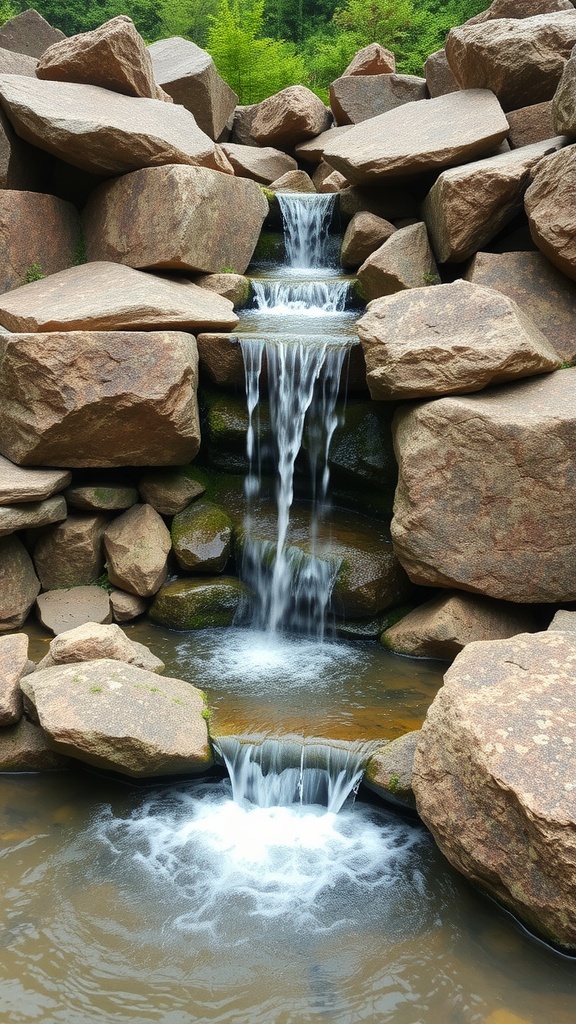
Water features can bring a refreshing touch to any landscape. Using large rocks in your design adds a natural look that blends beautifully with the surroundings. The image shows a lovely waterfall cascading over stones, creating a serene atmosphere.
When planning your water feature, consider the size and shape of the rocks. Larger stones provide stability and can create dramatic heights in your waterfall. Smaller stones can fill gaps and add texture. The flow of water over these stones can create soothing sounds, enhancing the overall experience.
Incorporating plants around the water feature can also enhance its beauty. Choose plants that thrive in moist conditions to create a lush environment. This combination of water, rocks, and greenery can transform your outdoor space into a peaceful retreat.
Enhancing Outdoor Seating Areas with Stone
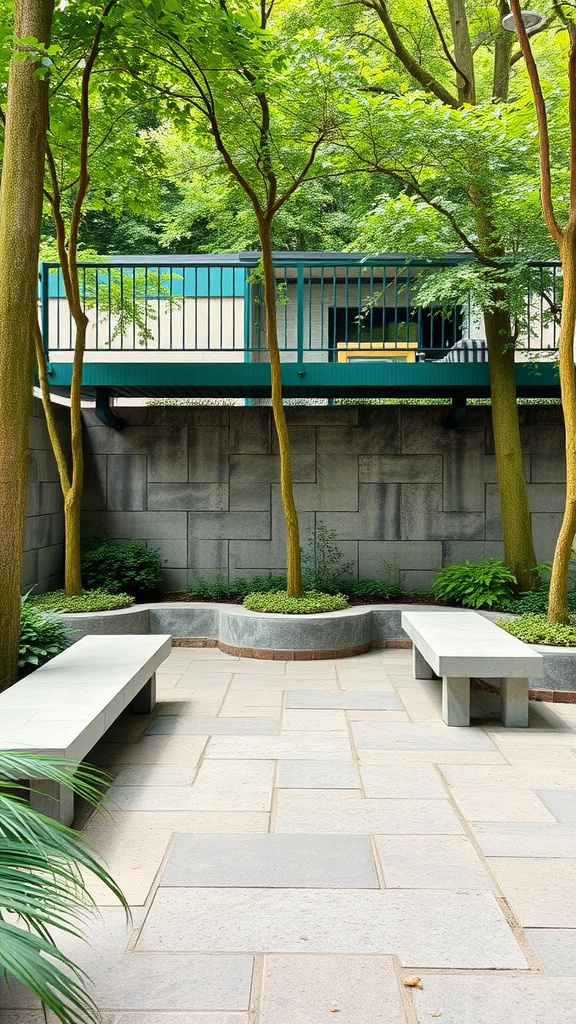
Using large rocks in your outdoor seating area can create a stunning focal point. The image shows a serene space with stone benches and a well-designed layout. This setup invites relaxation and conversation.
The combination of stone and greenery adds a natural touch. The trees surrounding the area provide shade, making it a perfect spot for gatherings. The stone benches are not just functional; they also blend seamlessly with the landscape.
Incorporating large rocks can define your seating area. They can act as borders or even as part of the seating itself. This approach gives a rustic feel while ensuring durability. Plus, stone is low-maintenance, which is always a bonus.
Consider how the stones complement the plants around them. The mix of textures and colors can enhance the overall look. Whether you choose smooth river rocks or rugged boulders, each option brings its own charm.
Building Retaining Walls with Rocks

Creating a retaining wall with large rocks can add both beauty and functionality to your landscape. The image shows a well-constructed stone wall that not only holds back soil but also enhances the overall look of the yard.
The rocks are stacked in a way that gives the wall a natural feel. This design allows for water drainage, which is important to prevent erosion. The green plants spilling over the rocks add a touch of life and color, making the wall blend seamlessly with the surrounding garden.
When building a retaining wall, it’s key to choose the right type of rock. Flat stones work well for stability, while rounded stones can create a more casual look. Make sure to layer the stones properly to ensure the wall is sturdy and can withstand the pressure from the soil behind it.
Adding plants around the wall can soften the hard edges and create a more inviting space. Consider using low-maintenance plants that thrive in your climate. This will not only beautify the area but also help with soil retention.
Rock Gardens for Low-Maintenance Landscaping
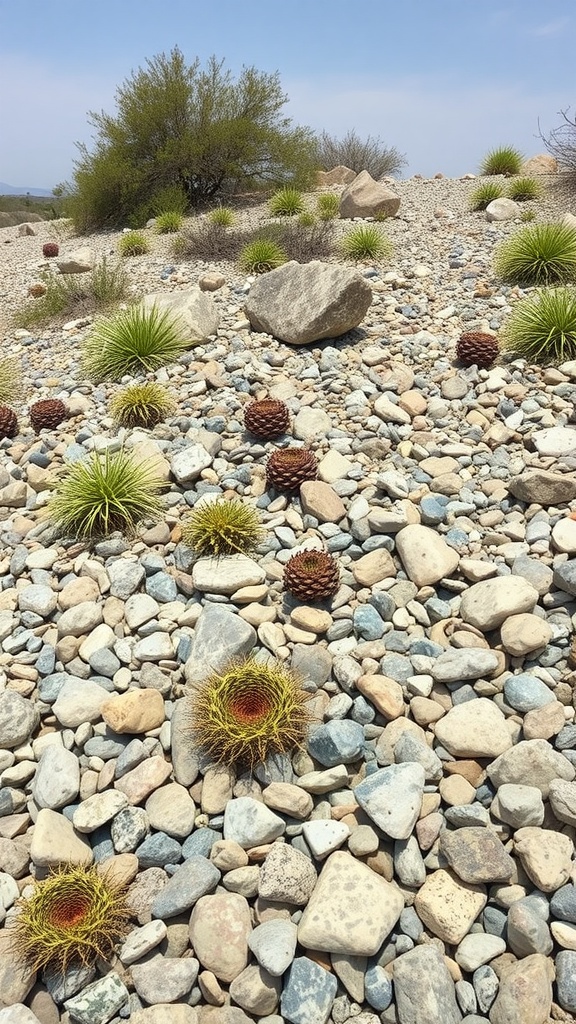
Rock gardens are a fantastic way to create a beautiful outdoor space without the hassle of constant upkeep. The image shows a stunning arrangement of large rocks and smaller pebbles, creating a natural look that blends seamlessly with the surrounding landscape.
In this garden, various plants peek through the rocks, adding a pop of color and texture. The use of drought-resistant plants is a smart choice, especially in areas with limited water. These plants thrive in rocky environments and require minimal care, making them perfect for busy homeowners.
The arrangement of rocks not only provides visual interest but also helps with drainage. This is crucial for maintaining healthy plants. Plus, the natural look of the rocks complements any home style, from modern to rustic.
Overall, rock gardens are an excellent option for anyone looking to enhance their yard with low-maintenance landscaping. They offer a unique aesthetic while being practical and easy to care for.
Creating Natural Pathways with Stone

Using large rocks and stones to create pathways in your garden adds a natural touch. The image shows a beautiful winding path made of stone slabs, surrounded by lush greenery and colorful flowers. This design invites you to stroll through the garden, making it feel welcoming and serene.
The stones are laid out in a way that blends seamlessly with the grass and plants. This not only enhances the beauty of the space but also provides a practical walking surface. The gentle curves of the path draw the eye and encourage exploration, making your outdoor area feel larger and more connected to nature.
Incorporating stones into your landscape can also help with drainage and soil erosion. The gaps between the stones allow water to flow through, keeping your plants healthy. Plus, the natural look of stone complements various garden styles, from modern to rustic.
Using Rocks for Erosion Control

Rocks are a fantastic way to manage erosion in your landscape. They create a natural barrier that helps hold soil in place. In the image, you can see a mix of large rocks and lush grass. This combination not only looks great but also serves a practical purpose.
The rocks act as a stabilizer for the soil on the slope. When it rains, water can wash away loose soil, leading to erosion. By placing rocks strategically, you can slow down the water flow and reduce the risk of soil loss. The grass growing around the rocks further helps by absorbing water and reinforcing the soil.
Using rocks for erosion control is not just functional; it adds texture and visual interest to your garden. The contrast between the smooth rocks and the vibrant greenery creates a beautiful landscape. Plus, it requires less maintenance than traditional methods like planting shrubs or installing barriers.
Incorporating rocks into your landscaping can be a smart choice for both aesthetics and practicality. It’s a simple way to enhance your outdoor space while protecting it from erosion.
Using Rocks for Plant Bed Borders
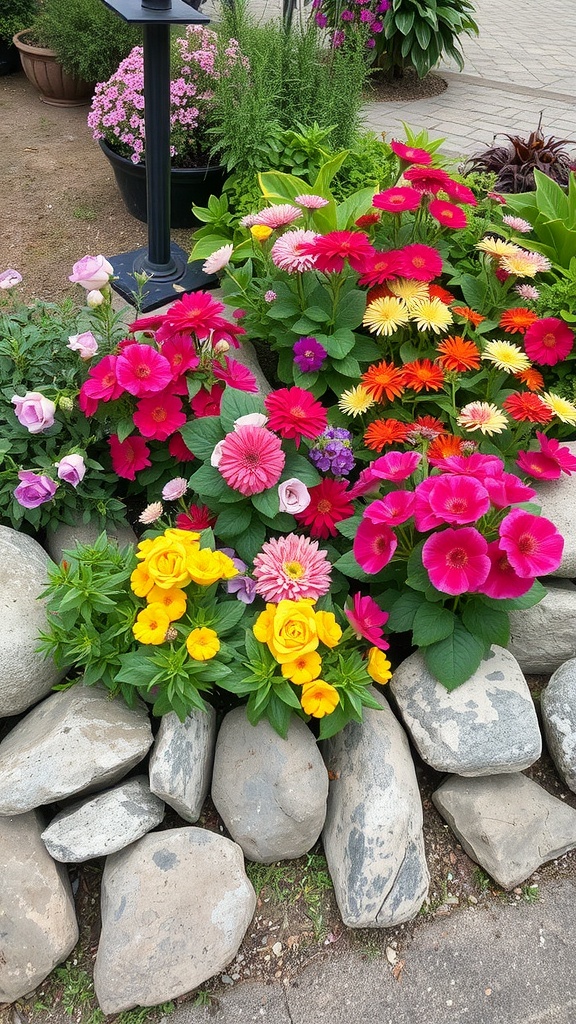
Rocks can be a fantastic way to define plant beds in your garden. They not only add a natural look but also help keep soil in place. In the image, you can see a vibrant display of flowers bordered by smooth stones. This creates a clear separation between the flower bed and the surrounding area.
The stones serve multiple purposes. They act as a barrier to prevent soil erosion while also providing a sturdy edge that helps maintain the shape of the bed. Plus, they add texture and visual interest to your garden.
Using rocks allows for creativity in your landscaping. You can choose different sizes and shapes to match your style. The combination of colorful flowers and natural stones in the image highlights how well these elements work together. It’s a simple yet effective way to enhance your outdoor space.
Incorporating Boulders as Focal Points

Boulders can really make a garden pop. They serve as stunning focal points that draw the eye and create a sense of stability. In the image, a large boulder sits proudly among vibrant flowers, showcasing how natural elements can blend beautifully with colorful blooms.
The rock’s texture and size contrast nicely with the soft petals of the surrounding flowers. This combination adds depth and interest to the landscape. Using boulders in your garden design can break the monotony and provide a natural feel.
When placing boulders, think about their positioning. A well-placed boulder can create a visual anchor, guiding visitors through the space. Pairing them with flowers like the bright yellows and pinks seen here enhances their appeal and makes the garden feel alive.
Creating Natural Steps with Large Stones
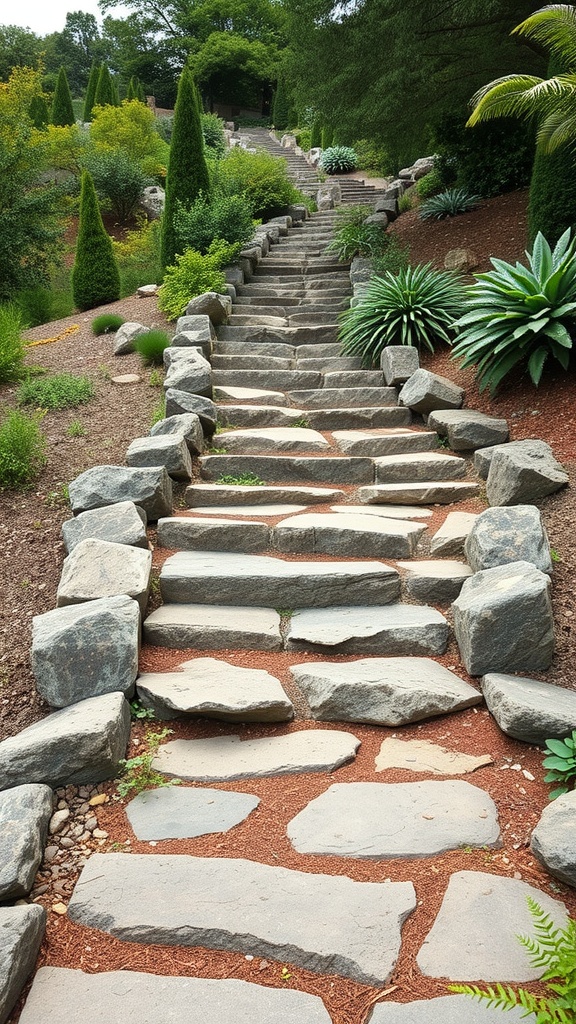
Using large stones to create steps in your garden can add a rustic charm. The image shows a beautiful stone pathway leading up a slope, surrounded by lush greenery. Each step is carefully placed, making it easy to walk on while blending seamlessly with nature.
These natural steps not only look great, but they also serve a practical purpose. They help manage the slope and prevent soil erosion. Plus, they create a clear path for visitors to follow, guiding them through your landscape.
When choosing stones, consider their size and shape. Larger stones can create a more dramatic look, while smaller ones can offer a more subtle appearance. Mixing different sizes can add visual interest and texture to your steps.
Don’t forget to incorporate plants around the stones. Low-growing plants can soften the edges and fill in gaps, enhancing the overall look. This combination of stone and greenery creates a welcoming atmosphere in any outdoor space.
Utilizing Rocks for Wildlife Habitats

Large rocks can create wonderful habitats for various wildlife. In the image, we see a big rock that provides shelter for small animals and birds. The space under the rock can be a cozy spot for critters to hide from predators or harsh weather.
Notice the plants around the rocks. They not only add beauty but also attract insects and birds. This creates a lively environment where wildlife can thrive. The pathway made of stones leads to the rock, making it easy for animals to navigate the area.
Using rocks in landscaping is not just about aesthetics; it’s about creating a balanced ecosystem. Birds, like the one in the image, often seek out these natural structures for nesting and foraging. Rocks can also help retain moisture in the soil, benefiting nearby plants.
Integrating Rocks into Zen Gardens

Zen gardens are all about simplicity and tranquility. The image shows a serene space with smooth, rounded rocks scattered across soft sand. This design invites a sense of calm and encourages mindfulness.
The rocks serve as focal points, drawing the eye and creating balance. Their natural shapes and colors blend beautifully with the surrounding elements. A small bamboo structure adds a touch of charm, enhancing the peaceful vibe.
Using larger rocks in your Zen garden can symbolize mountains or islands, representing stability and permanence. This can help create a meditative space where you can unwind and reflect.
Incorporating greenery, like the small plant seen here, adds life and contrast. It softens the hard edges of the rocks and brings a refreshing touch to the overall design. Together, these elements create a harmonious environment that promotes relaxation.
Using Rocks for Artistic Sculptures in Gardens
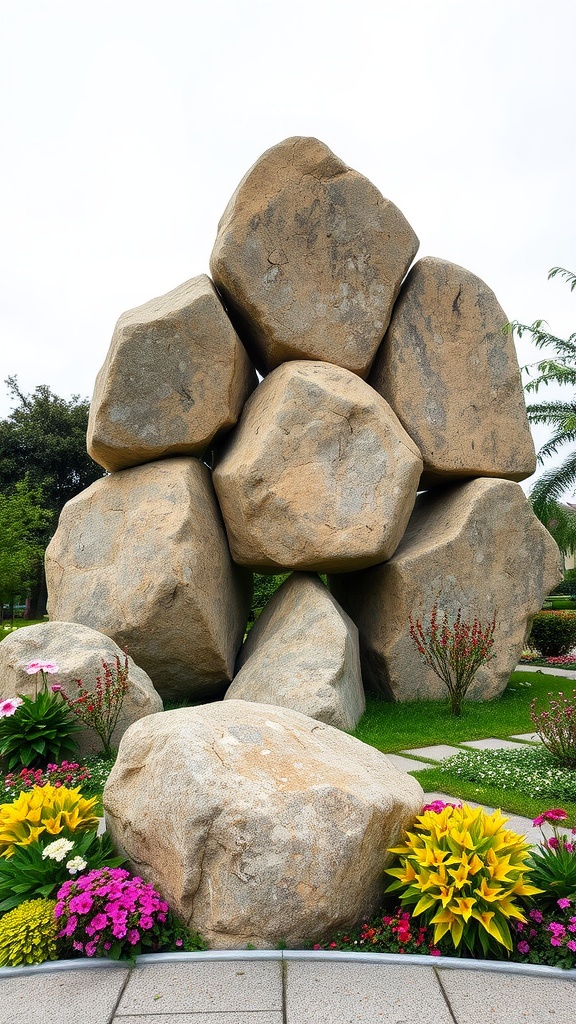
Rocks can be more than just a part of the landscape; they can become stunning focal points in your garden. The image shows a striking arrangement of large rocks, stacked in an artistic manner. This kind of sculpture can add a unique touch to your outdoor space.
Creating rock sculptures allows for creativity. You can choose different shapes and sizes to fit your garden’s theme. The rocks in the image are not just randomly placed; they create a sense of balance and harmony. Surrounding them with colorful flowers enhances their beauty and draws attention to the sculpture.
When designing with rocks, think about how they interact with the plants around them. The vibrant flowers in the image contrast beautifully with the earthy tones of the rocks. This combination can make your garden feel lively and inviting.
Using rocks for artistic sculptures can also be a conversation starter. Visitors will appreciate the thought and effort you put into your garden design. Whether you prefer a modern look or a more natural feel, rocks can help you achieve your vision.
Creating Borders for Vegetable Gardens with Rocks

Using large rocks to create borders for your vegetable garden is both practical and visually appealing. The image shows a vibrant garden filled with leafy greens and bright orange pumpkins, all neatly framed by sturdy stones. This setup not only defines the garden space but also adds a natural aesthetic.
Rocks serve multiple purposes in a garden. They help keep soil in place, preventing erosion, and can also deter pests. The sturdy nature of the rocks means they won’t easily shift or break down over time, making them a long-lasting choice for borders.
In the image, the rocks are arranged in a way that complements the lush plants. This creates a cozy, inviting feel. You can mimic this look by choosing rocks that match your garden’s style. Whether you prefer smooth river stones or rugged boulders, there’s a rock type for every garden.
Adding rocks around your vegetable garden can also help with drainage. They allow water to flow through while keeping the soil contained. This is especially helpful in areas with heavy rainfall. Plus, the rocks can absorb heat from the sun, which can benefit your plants during cooler nights.
Overall, using rocks as borders is a smart choice for any vegetable garden. They provide structure, enhance beauty, and support plant health. So, if you’re planning your next garden project, consider incorporating large rocks for a practical and stylish touch.
Incorporating Rocks into Coastal Landscapes
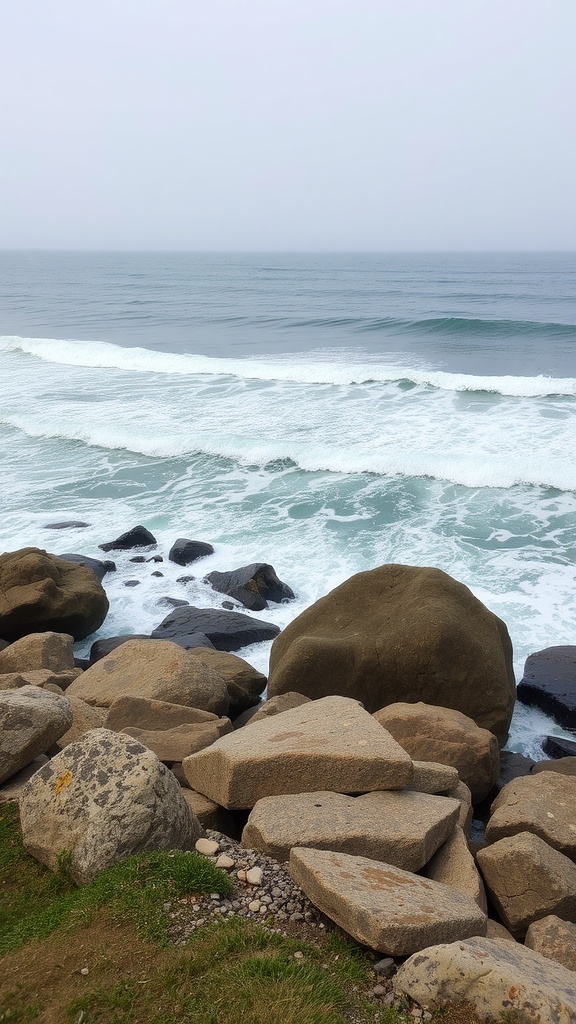
Coastal landscapes offer a unique opportunity to blend natural elements with design. Large rocks can serve as both functional and aesthetic features. They create a natural barrier against waves while adding texture to the shoreline.
In the image, you can see a variety of large rocks along the coast. These stones not only stabilize the beach but also create a stunning visual contrast against the rolling waves. The rugged shapes and earthy tones of the rocks complement the soft blues of the ocean beautifully.
Using rocks in your coastal landscape can enhance the natural beauty of the area. You can arrange them in clusters or line them along pathways. This approach invites visitors to explore while keeping the environment intact. Plus, they require little maintenance, making them a practical choice.
Consider adding plants around the rocks to soften the look. Native grasses and low-growing shrubs can thrive in sandy soil, creating a harmonious blend of land and sea. This not only boosts the visual appeal but also supports local wildlife.
Designing Fire Pits with Stone Surrounds
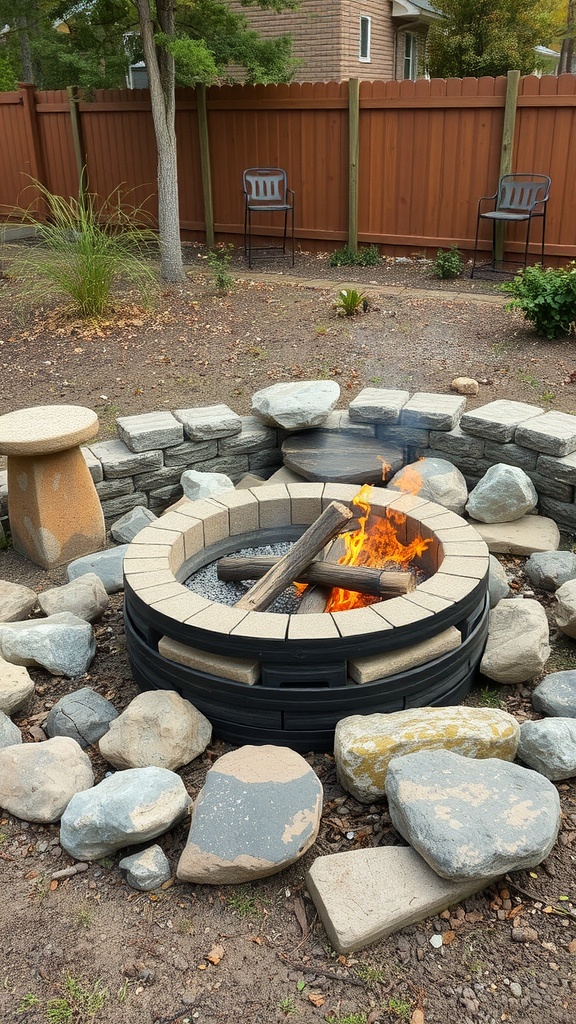
Creating a cozy fire pit area can transform your outdoor space into a welcoming retreat. The image shows a well-designed fire pit surrounded by large stones, which adds a natural touch to the setting. The circular design of the fire pit is both functional and inviting, making it a perfect spot for gatherings.
The stones around the fire pit serve multiple purposes. They not only enhance the aesthetic appeal but also provide safety by containing the fire. Using a mix of sizes and shapes can create a rustic look that blends seamlessly with the landscape. The larger rocks add stability and character, while smaller stones fill in the gaps, making the area feel complete.
Incorporating seating around the fire pit is essential for comfort. The image features simple chairs that offer a great place to relax and enjoy the warmth of the fire. Consider adding cushions or blankets for extra coziness during cooler evenings.
Lighting is another key element. Soft lighting around the fire pit can create a magical atmosphere. String lights or lanterns can enhance the space, making it perfect for evening gatherings.
Overall, designing a fire pit with stone surrounds is a fun project that can elevate your outdoor experience. Whether you’re roasting marshmallows or sharing stories, this space can become a cherished part of your home.
Creating Privacy Screens with Stacked Stones
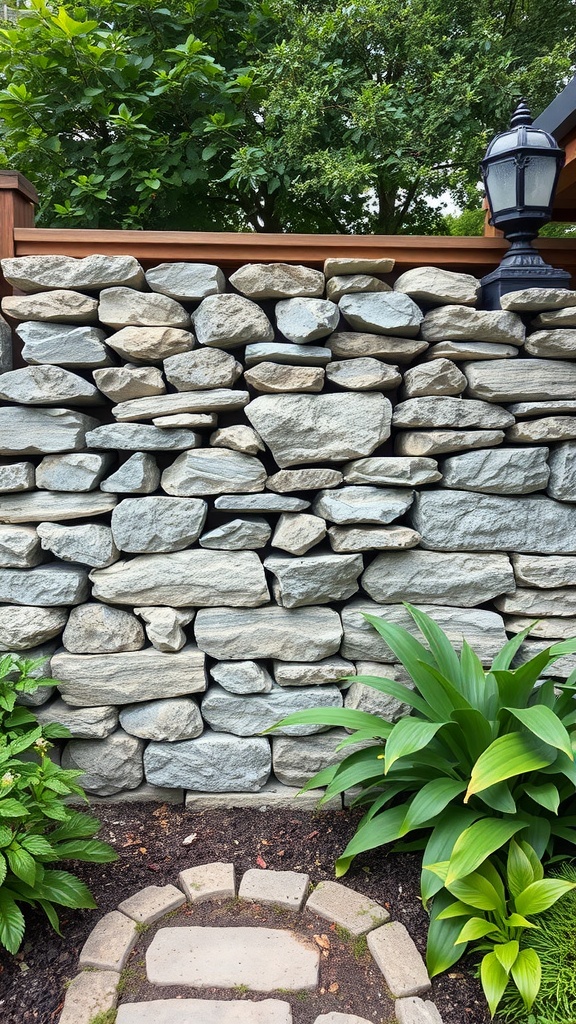
Using stacked stones is a fantastic way to create privacy screens in your yard. The image shows a sturdy stone wall, perfectly arranged to provide both function and style. The natural look of the stones blends well with the surrounding greenery, making it a great choice for any garden.
This type of wall not only blocks unwanted views but also adds a rustic charm to your outdoor space. The varying shapes and sizes of the stones create an interesting texture that draws the eye. You can easily customize the height and width to fit your needs.
Incorporating plants around the stone wall enhances the overall look. The lush greenery at the base of the wall softens the hard edges of the stones, creating a balanced feel. Pathways leading up to the wall can also add a welcoming touch to your garden.
Designing Pathway Edges with Decorative Stones
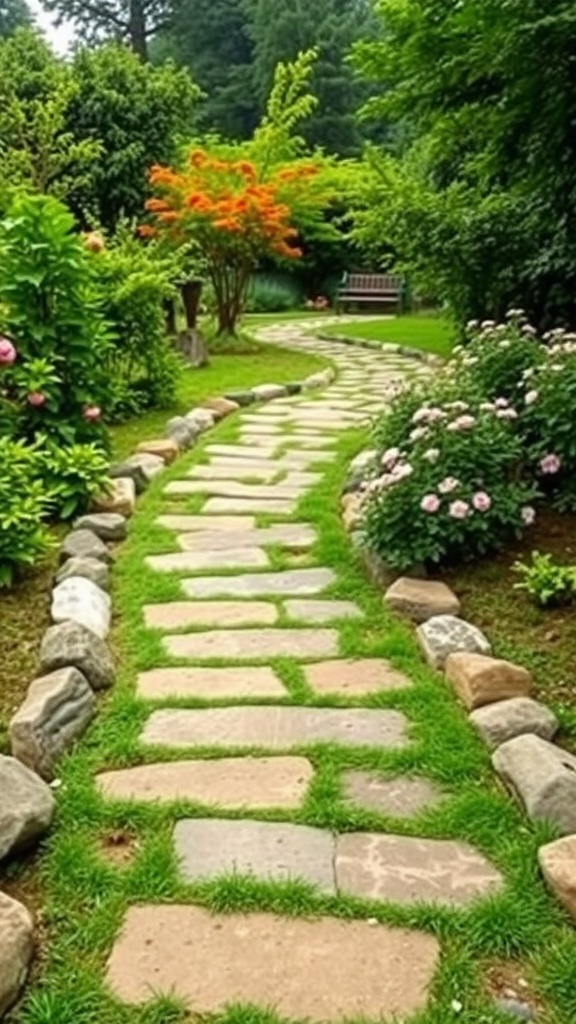
Creating a beautiful pathway in your garden can be a fun project. The image shows a winding path made of large stones, bordered by decorative rocks. This design not only guides visitors through the garden but also adds a natural touch.
The stones used for the pathway are flat and smooth, making them easy to walk on. They are placed with small patches of grass in between, which softens the look and feels inviting. The edges of the path are lined with various decorative stones, adding texture and contrast.
Surrounding the pathway, lush greenery and colorful flowers create a vibrant atmosphere. This combination of elements makes the path a focal point, encouraging exploration and enjoyment of the garden space.
When designing your own pathway, consider using different sizes and shapes of stones. This can create a more dynamic look. You can also mix in some plants along the edges to enhance the natural feel.
Utilizing Rocks for Seasonal Decor

Rocks can add a unique touch to your seasonal decorations. In the image, large rocks serve as a sturdy base for festive decor. A vibrant wreath hangs nearby, bringing a pop of color to the natural stone.
Using rocks in your landscaping allows for creativity. You can place ornaments or seasonal plants around them, making a lovely display. The combination of rocks and seasonal items creates a welcoming atmosphere.
Consider adding some greenery or colorful flowers to complement the stones. This mix can enhance the overall look and feel of your outdoor space. Rocks not only provide structure but also make your seasonal decor stand out.
Creating Natural Stone Pathways
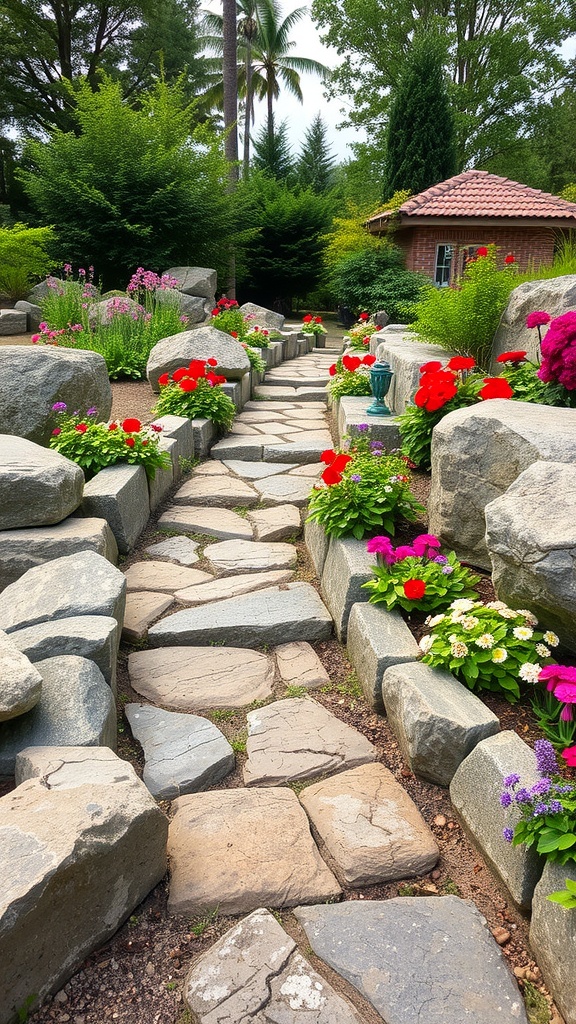
Natural stone pathways add a rustic charm to any garden. The image shows a beautiful stone path lined with vibrant flowers and greenery. This creates a welcoming atmosphere that invites you to stroll through the landscape.
Using large rocks for pathways not only enhances the visual appeal but also provides a durable surface. The stones are arranged thoughtfully, allowing for easy navigation while blending seamlessly with the surrounding plants. This design encourages exploration and connection with nature.
Incorporating flowers along the edges softens the hardscape, adding color and life. The bright reds and purples pop against the earthy tones of the stones, creating a lively contrast. This combination makes the pathway a focal point in the garden.
When planning your own stone pathway, think about the flow of the space. Make sure it leads to key areas, like seating or a garden feature. This will enhance the overall experience of your outdoor space.
